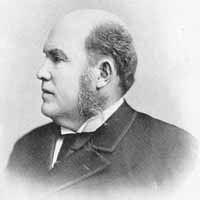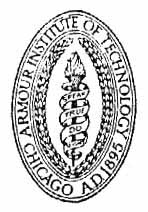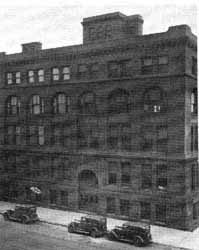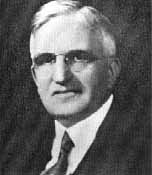The following is an edited version of an essay published in 1937 in the Armour Engineer and Alumnus written by Walter Hendricks. Three years later Armour Institute of Technology and Lewis Institute merged to create Illinois Institute of Technology.
The story of the founding of Armour Institute of Technology does not begin with the opening of its doors in September, 1893. It goes back to a mission Sunday school in which Joseph F. Armour, a merchant of considerable means, was interested and to which he contributed liberally for its support. This mission, started in 1874, three years after the Chicago Fire, at Thirty-first and State streets, was called Plymouth Mission because it was an extension of the activities of Plymouth Church, of which Joseph F. Armour was a member.

When Joseph F. Armour died, in 1881, he left a bequest of $100,000 to be used by his brother, Philip D. Armour, in establishing a Sunday school for the people of the community. To this amount, Philip D. Armour added $100,000 of his own, and he built "Armour Mission."
The mission was to be broad and wholly non-sectarian, free and open to all to the full extent of its capacity, without any restrictions whatsoever as to race, creed or class. On the first Sunday in December, 1886, seven hundred little cosmopolitans "crashed the gates" to be counted among its first members. Among the many workers and teachers sent from Plymouth Church to assist in this experiment in practical Christian democracy, Julia A. Beveridge must be singled out for special consideration. Appointed mission librarian in 1887, she tried to stimulate an interest in reading. Soon realizing, however, that storybooks were not enough to keep idle hands and minds from mischief, she started a class in clay modeling.
Surprised at the outcome, she enlisted the services of five young men from a manual training school to teach wood carving, tile-making, freehand and mechanical drawing, and designing. Before the end of the year she had 400 boys in the Saturday morning classes, and 350 girls in the afternoon classes in dress-cutting and millinery. Little did she realize that she was laying foundation for Armour Institute of Technology.
We must go back now to Plymouth Church, where Philip D. Armour is listening to a sermon by Frank W. Gunsaulus, a young man in his thirties, a silver-tongued orator and pastor of a large and wealthy Chicago church, declaring what he would do if he had a million dollars. He would establish a school to help young people who wanted to help themselves. That sermon is a classic.
"Do you believe in those ideas you have just expressed?" the rich merchant asked the poor minister after the service. "I assuredly do," was the firm response. "Would you carry them out if you had the means?" the packer questioned. "Most certainly," said the preacher. "Very well," replied the decisive Armour; "if you will give me five years of your time, I will give you the money."

These, then speaking generously, were the founders of Armour Institute of Technology: Joseph F. Armour, who left a bequest for a mission; Julia A. Beveridge, who formed classes in handiwork; Frank W. Gunsaulus, who preached a sermon on what he would do with a million dollars; and Philip D. Armour, who supplied the means for building the school.
Gunsaulus and Armour were not sure, despite the sermon, what kind of school they wanted to build. Only one thing they were certain of: it was to be practical and designed for young people who wanted to help themselves. They finally came to a decision. In the Mission Visitor of October, 1890, we read as follows: "Mr. Armour is now erecting a large manual training school."
The merchant and the minister watched daily their dream taking shape stone by stone. You see, it was a practical and realistic dream. And as the building grew, so grew their plans. Armour and Gunsaulus were raising their monument to the practical educational needs of a new world - a technical college, with departments of mechanical and electrical engineering, architecture, and library science, and other departments or schools, of domestic arts, of commerce, of music, and of kindergartens. On December 1, 1892, Frank W. Gunsaulus took office as the first president of Armour Institute.

A month before the opening, four hundred students had been enrolled, and applications were coming in with every mail. The faculty, all carefully selected, some of the men outstanding in their fields, were busy receiving and installing the various apparatus which, it was claimed, would make the new Institute more complete than any other technological institute in the country. Proudest they were of their mechanical and electrical equipment. The [1893 World's Columbian Exposition held in Chicago] had been one of their principal hunting grounds, and nearly anything of value is said to have had the Institute purchase tag attached to it.
The initial courses offered in the technical college were mechanical, electrical and mining engineering. The last was discontinued at the end of the first year. Important, permanent additions were civil engineering in 1899; chemical engineering in 1901; and fire protection engineering, the only course of its kind in the country in 1903.
In 1893, the trustees of Armour Institute and the directors of the Art Institute of Chicago held a significant meeting and made the momentous decision to join hands and run the architectural branches of the two institutions in conjunction with each other. The new school just formed was to be known as the Chicago School of Architecture of the Armour Institute, the scientific courses to be taught by Armour and the artistic courses by the Art Institute.
One of the leading engineering magazines declared that "the establishment within a single year of two great institutions of learning, the one a great university [the University of Chicago] and the other which promises to become a great school of technology [Armour Institute], is an event unique in the history of modern cities, and of which Chicago, at present occupied with her great World's Fair, will one day be quite proud."
In this same year the Field Columbian Museum and the Chicago Academy of Sciences were also established, and the Chicago Art Institute enlarged. This astonishing development in higher education and the growth of educational institutions in the World's Fair period was referred to by one Chicago newspaper as "on a scale worthy to be called ‘Chicagoan'". It added, "the youth who are to make the future Chicago the ideal city of the world, the real center of the arts and belles-lettres, no longer have to seek training elsewhere..." and referred to Mr. Armour as one of the first to feel the impulses of the new educational movement in Chicago and one of the most practical in giving it realization.
One of the greatest public orators of his time, Dr. Gunsaulus was always inviting his friends to speak from the mission platform. What an opportunity the students enjoyed! Himself a liberal, Dr. Gunsaulus knew no barrier of color, or class, or creed, not of economic or political point of view. Excerpts from those speeches would make interesting reading.
In the years to come he would have Booker T. Washington, who, with Lincoln-like simplicity called upon the students to lend their co-operation in solving the Negro problem. "The problem does not concern the black man alone. As we rise, you rise. As we fall, you fall. You can't harm us without harming yourself, and the deeper you reach down to lift up another, the stronger you will be for it." Later, President Eliot of Harvard [was an invited speaker], and at the twentieth centennial, William Howard Taft, President of the United States of America.

The year 1901 was a most important one. Dr. Gunsaulus had resigned the presidency during the previous summer because of ill health; and the school was in the hands of an acting president, Professor V. C. Alderson. Philip D. Armour, likewise, had been ill, suffering from heart trouble; and on January 6, at the age of 68, he passed away. The amount of investment he had made in the Mission and the Institute was said to be nearly three million dollars. Three months later, Mrs. Philip D. Armour and her son, J. Ogden Armour added another million dollars to that investment, and urged Dr. Gunsaulus to resume his presidency, after an absence of eight months, and to assist in planning an even larger school.
Upon meeting trustee and former president Gunsaulus on the street and casually informing him of the million dollar gift, J. Ogden Armour said to him, "I just wanted to tell that I consider the west to offer a great field for work in engineering and technology and that I want Armour Institute to be one of the leading schools of technology in the world." Dr. Gunsaulus went even further in his reply. "This gift," he said, "will allow the school to branch out and take its place as the greatest technological school in the world." The Chicago Tribune, commenting on the plan for an enlarged school, said, "with such an institution supplementing the two universities, the museums, academies, and libraries of Chicago, the educational opportunities afforded by this city would be very nearly complete."

Later that year, to meet the expanding requirements of the course in mechanical engineering, Machinery Hall was constructed at a cost of over $100,000, a gift of Mrs. P. D. Armour and J. Ogden Armour. This building was ready for use at the opening of school the following year.
[In 1904, the Institute received a large gift of land from J. Ogden Armour.] This tract, worth a quarter of a million, and lying north of the Mission, was to be turned into an athletic field, the lack of which had forced the teams to practice in the American league baseball park at Thirty-ninth street and Wentworth avenue or in the playground of a school nearby.
It was about this time that correspondence schools had their vogue. Believing that the work of education in technical subjects by means of correspondence schools could be made efficient and helpful beyond what had hitherto been accomplished, Dr. Gunsaulus made arrangements with the American School of Correspondence, established in Boston, in 1897, and now moving to Chicago, to conduct this work with the assistance of the Institute's faculty.
Besides the instruction it gave, the correspondence course spread the name of Armour Institute of Technology to the uttermost parts of the earth. Students from every country and climate, from the Fiji Islands, Argentine, Korea, Alaska, Moscow, Trinidad, Peru, Australia, and over 300 from New Zealand registered for the courses. The aim was to bring a technical education within the reach of the workingman. After a few years, this affiliation was dissolved, the correspondence school establishing itself elsewhere in its own quarters.
On the entrance of this country into the World War I, Armour Institute of Technology, as other schools, was turned into a training camp, the widest possible use being made of its technical facilities.
Later, in the midst of plans for the future, Dr. Frank W. Gunsaulus died, on March 17, 1921, at the age of 65. Of his 34 years as a citizen of Chicago, at least 30 had been spent on Armour Institute of Technology, which had become the primary object of his life. He was preeminently a man of action, and a genius for administration. His death occurred at a very critical moment. To Howard Monroe Raymond fell the difficult task of carrying on the work. A member of the faculty since 1895, and dean of engineering from 1903, he took over the duties of the presidency, receiving the permanent appointment in May, 1922.
For the maintenance of the Institute during this critical period, when even the old endowment of the Mission and the Institute had practically vanished, alumni, faculty, trustees, students, and officers of administration pledged their support for the next five years. Then came the Great Depression.

It is on this plan of making the Armour Institute of Technology one of the best technological institutions in the world, that the present head, Dr. Willard E. Hotchkiss, as well as others who have the affairs of the Institute at heart, is working. Prospects are bright. We have the largest enrollment in history, - over 3000 students. Eminent scientists and engineers, known the world over, have been added to the faculty. Graduate work is flourishing. A research foundation has been working hand in hand with industry on problems of great importance. Hundreds of students are registered in the cooperative course, alternating their time in school and shop, over a five-year period.
A generous benefactor could leave no better monument than here at Armour Institute of Technology, situated in the heart of America, in the center of trade, and industry, and culture.
Editor's Note: The Historical Sketch ends here. In 1937, Henry T. Heald became president and several years later, he entered into merger discussions with Lewis Institute, a proposal which came into reality in 1940. Dr. Heald continued as President of the new school, Illinois Institute of Technology, until 1952.
Image Credits
Philip D. Armour: 1900 Integral
Julia Beveridge: Irene Macauley, The Heritage of Illinois Institute of Technology (Chicago: Illinois Institute of Technology, 1978)
Frank W. Gunsaulus: 1900 Integral
Armour Institute Seal
Machinery Hall: Macauley, The Heritage of Illinois Institute of Technology
Willard Hotchkiss: Macauley, The Heritage of Illinois Institute of Technology



